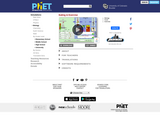
Students will learn the vocabulary words associated with tobacco and the negative effects tobacco has on the human body.
- Subject:
- Health Education
- Material Type:
- Lesson
- Author:
- Utah Lesson Plans
- Date Added:
- 01/11/2022

Students will learn the vocabulary words associated with tobacco and the negative effects tobacco has on the human body.

Students will increase their knowledge of Internet safety. Students will explore and identify dangers on the Internet and learn ways to avoid situations that might be threatening or harmful.

The decisions teenagers make are influenced by many factors. This lesson will help students differentiate between a variety of influences and recognize the impact these influences have on decision making.This lesson is written as an interdisciplinary unit for both the Health and Language Arts classrooms. It can however, be taught in just one of the classes.

In this visualization adapted from the University of Massachusetts Medical School, discover the role that dengue viral proteins play in a human cell as the virus prepares to replicate.

This lesson is adapted from Google's Be Internet Awesome Lesson 1: Share With Care. It specifically focuses on Activity 1: When not to share and Activity 4: Keeping it Private.

In this assignment, students will work together to create a digital story on the importance of digital citizenship.

Students create a digital story about their personal and family health history or a specific health concern.

This video segment adapted from A Science Odyssey tells the story of researcher Sir Alexander Fleming, whose luck and scientific reasoning led to the groundbreaking discovery of penicillin.

The students will play beach ball glo-germ. Students will gather information about a disease of their choice using Utah's Online Library resources. The students will use Utah's Online Library to cite their sources. The students will create their disease project in google slides.

Students will identify what makes them unique. Students will identify physical differences and similarities between themselves and other students. Students will learn the effects of treating people different because of race, culture or ethnic backgrounds. Students will learn to accept others differences.

At the completion of this lesson students will be able to: identify situations that trigger stress; distinguish between eustress and distress; describe the stress response and how it influences performance; and develop strategies for managing or reducing stress.

This lesson helps students develop strategies for managing or reducing stress.

Students will identify types of drugs, the short and long-term effects, and identify strategies for maintaining a drug-free lifestyle.

This lesson integrates Health Standard 6 (dysfunctional eating) with Language Arts Standard 7 (imperative writing). It teaches students the dangers of dysfunctional eating. Students create a recipe for a healthy snack and present it to the class both orally and in written format.

Students will demonstrate health-promoting and risk-reducing behaviors to prevent substance abuse. Students will also demonstrate independent research to find academic information.

In this lesson we will talk about why it is important to be healthy. We will use lots of pictures and class participation.

Students will create menus for a restaurants in small groups. The class will use them as a basis to order a healthy meal. Students need to know the difference between an "everyday food" and a "sometimes food." "Everyday foods" provide excellent fuel for the body to work efficiently and "sometimes foods" provide inferior fuel to the body. We CHOOSE what food to put into our bodies. When we choose healthy foods, our bodies work better and we live longer, stronger lives. If we select unhealthy foods to eat most of the time,our bodies will have trouble working efficiently and will place us at an increased risk of developing cardiovascular disease or stroke.

How many calories are in your favorite foods? How much exercise would you have to do to burn off these calories? What is the relationship between calories and weight? Explore these issues by choosing diet and exercise and keeping an eye on your weight.

The students will understand how a healthy diet and regular exercise can help them to be healthy and happy, both physically and mentally.

Watch the linked video and ask your child(ren) to hold up a card to show how they are feeling when they hear a specific piece of music.